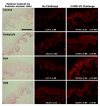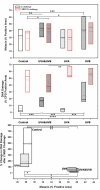The deceptive nature of UVA tanning versus the modest protective effects of UVB tanning on human skin
- PMID: 20979596
- PMCID: PMC3021652
- DOI: 10.1111/j.1755-148X.2010.00764.x
The deceptive nature of UVA tanning versus the modest protective effects of UVB tanning on human skin
Abstract
The relationship between human skin pigmentation and protection from ultraviolet (UV) radiation is an important element underlying differences in skin carcinogenesis rates. The association between UV damage and the risk of skin cancer is clear, yet a strategic balance in exposure to UV needs to be met. Dark skin is protected from UV-induced DNA damage significantly more than light skin owing to the constitutively higher pigmentation, but an as yet unresolved and important question is what photoprotective benefit, if any, is afforded by facultative pigmentation (i.e. a tan induced by UV exposure). To address that and to compare the effects of various wavelengths of UV, we repetitively exposed human skin to suberythemal doses of UVA and/or UVB over 2 weeks after which a challenge dose of UVA and UVB was given. Although visual skin pigmentation (tanning) elicited by different UV exposure protocols was similar, the melanin content and UV-protective effects against DNA damage in UVB-tanned skin (but not in UVA-tanned skin) were significantly higher. UVA-induced tans seem to result from the photooxidation of existing melanin and its precursors with some redistribution of pigment granules, while UVB stimulates melanocytes to up-regulate melanin synthesis and increases pigmentation coverage, effects that are synergistically stimulated in UVA and UVB-exposed skin. Thus, UVA tanning contributes essentially no photoprotection, although all types of UV-induced tanning result in DNA and cellular damage, which can eventually lead to photocarcinogenesis.
2010 John Wiley & Sons A/S. This article is a US Government work and is in the public domain in the USA.
Figures





Similar articles
-
Photobiological implications of melanin photoprotection after UVB-induced tanning of human skin but not UVA-induced tanning.Pigment Cell Melanoma Res. 2015 Mar;28(2):210-6. doi: 10.1111/pcmr.12331. Epub 2015 Jan 5. Pigment Cell Melanoma Res. 2015. PMID: 25417821 Free PMC article. Clinical Trial.
-
[Ultraviolet A-induced DNA damage: role in skin cancer].Bull Acad Natl Med. 2014 Feb;198(2):273-95. Bull Acad Natl Med. 2014. PMID: 26263704 French.
-
Pigmentation effects of solar-simulated radiation as compared with UVA and UVB radiation.Pigment Cell Melanoma Res. 2008 Aug;21(4):487-91. doi: 10.1111/j.1755-148X.2008.00470.x. Epub 2008 Jun 20. Pigment Cell Melanoma Res. 2008. PMID: 18627527 Free PMC article. Clinical Trial.
-
Sunscreens containing the broad-spectrum UVA absorber, Mexoryl SX, prevent the cutaneous detrimental effects of UV exposure: a review of clinical study results.Photodermatol Photoimmunol Photomed. 2008 Aug;24(4):164-74. doi: 10.1111/j.1600-0781.2008.00365.x. Photodermatol Photoimmunol Photomed. 2008. PMID: 18717957 Review.
-
Effects of ultraviolet radiation, visible light, and infrared radiation on erythema and pigmentation: a review.Photochem Photobiol Sci. 2013 Jan;12(1):54-64. doi: 10.1039/c2pp25152c. Photochem Photobiol Sci. 2013. PMID: 23111621 Review.
Cited by
-
Visible Light Induces Melanogenesis in Human Skin through a Photoadaptive Response.PLoS One. 2015 Jun 29;10(6):e0130949. doi: 10.1371/journal.pone.0130949. eCollection 2015. PLoS One. 2015. PMID: 26121474 Free PMC article.
-
Induction of retinal-dependent calcium influx in human melanocytes by UVA or UVB radiation contributes to the stimulation of melanosome transfer.Cell Prolif. 2017 Dec;50(6):e12372. doi: 10.1111/cpr.12372. Epub 2017 Aug 23. Cell Prolif. 2017. PMID: 28833830 Free PMC article.
-
Shining light on skin pigmentation: the darker and the brighter side of effects of UV radiation.Photochem Photobiol. 2012 Sep-Oct;88(5):1075-82. doi: 10.1111/j.1751-1097.2012.01138.x. Epub 2012 Apr 12. Photochem Photobiol. 2012. PMID: 22404235 Free PMC article. Review.
-
Understanding Mechanisms and Key Factors Influencing Melanogenesis for the Management of Melasma: An Updated Review.Curr Pharm Biotechnol. 2025;26(10):1564-1581. doi: 10.2174/0113892010301957240424110023. Curr Pharm Biotechnol. 2025. PMID: 38738729 Review.
-
Photobiological implications of melanin photoprotection after UVB-induced tanning of human skin but not UVA-induced tanning.Pigment Cell Melanoma Res. 2015 Mar;28(2):210-6. doi: 10.1111/pcmr.12331. Epub 2015 Jan 5. Pigment Cell Melanoma Res. 2015. PMID: 25417821 Free PMC article. Clinical Trial.
References
-
- Abdel-Malek ZA, Kadekaro AL, Swope VB. Stepping up melanocytes to the challenge of UV exposure. Pigment Cell Melanoma Res. 2010;23:171–186. - PubMed
-
- Agar N, Young AR. Melanogenesis: a photoprotective response to DNA damage? Mutat. Res. 2005;571:121–132. - PubMed
-
- Bennett DC. Ultraviolet wavebands and melanoma initiation. Pigment Cell Melanoma Res. 2008;21:520–524. - PubMed
-
- Berneburg M, Grether-Beck S, Kurten V, Ruzicka T, Briviba K, Sies H, Krutmann J. Singlet oxygen mediates the UVA-induced generation of the photoaging-associated mitochondrial common deletion. J. Biol. Chem. 1999;274:15345–15349. - PubMed
Publication types
MeSH terms
Substances
Grants and funding
LinkOut - more resources
Full Text Sources
Other Literature Sources
Medical
Miscellaneous

